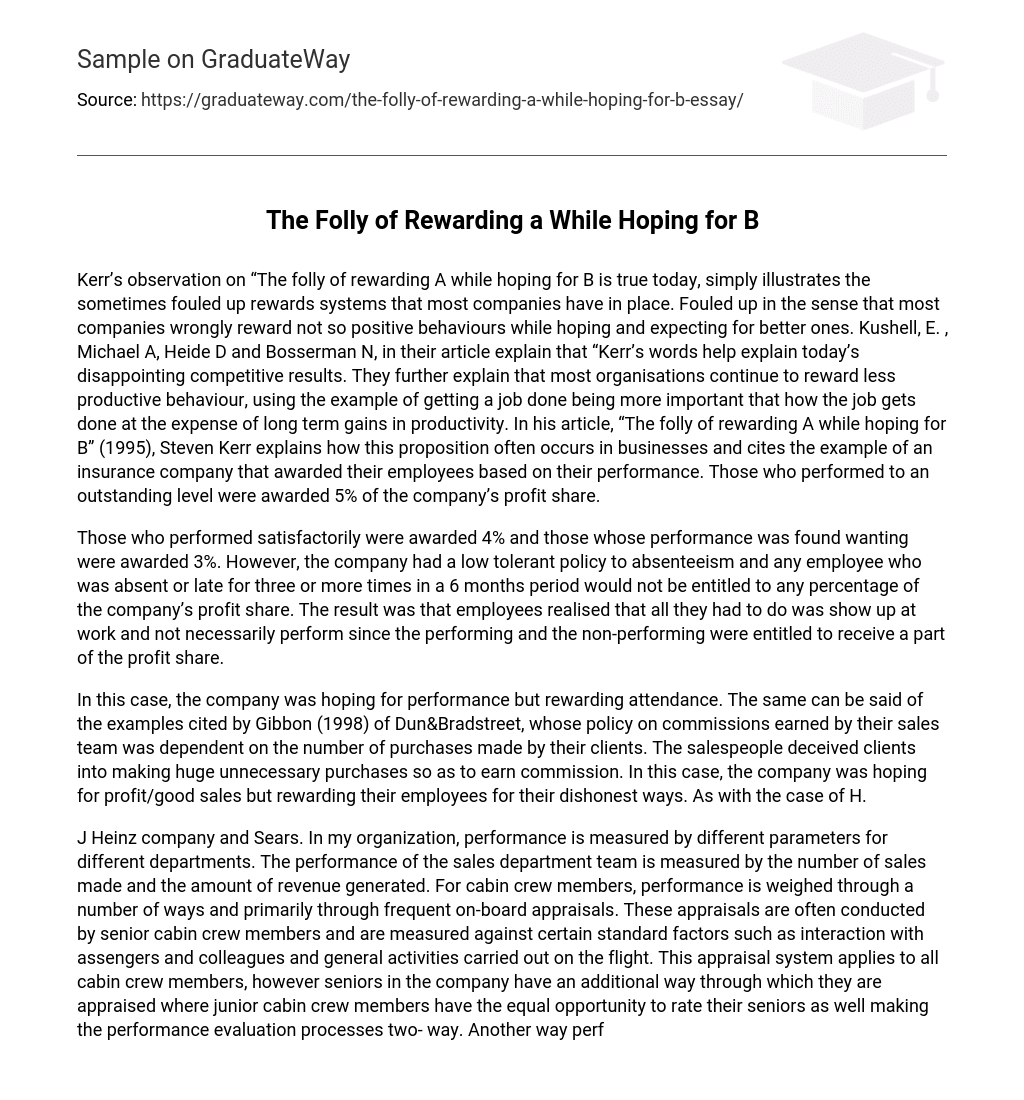Kerr’s observation on “The folly of rewarding A while hoping for B is true today, simply illustrates the sometimes fouled up rewards systems that most companies have in place. Fouled up in the sense that most companies wrongly reward not so positive behaviours while hoping and expecting for better ones. Kushell, E. , Michael A, Heide D and Bosserman N, in their article explain that “Kerr’s words help explain today’s disappointing competitive results. They further explain that most organisations continue to reward less productive behaviour, using the example of getting a job done being more important that how the job gets done at the expense of long term gains in productivity. In his article, “The folly of rewarding A while hoping for B” (1995), Steven Kerr explains how this proposition often occurs in businesses and cites the example of an insurance company that awarded their employees based on their performance. Those who performed to an outstanding level were awarded 5% of the company’s profit share.
Those who performed satisfactorily were awarded 4% and those whose performance was found wanting were awarded 3%. However, the company had a low tolerant policy to absenteeism and any employee who was absent or late for three or more times in a 6 months period would not be entitled to any percentage of the company’s profit share. The result was that employees realised that all they had to do was show up at work and not necessarily perform since the performing and the non-performing were entitled to receive a part of the profit share.
In this case, the company was hoping for performance but rewarding attendance. The same can be said of the examples cited by Gibbon (1998) of Dun&Bradstreet, whose policy on commissions earned by their sales team was dependent on the number of purchases made by their clients. The salespeople deceived clients into making huge unnecessary purchases so as to earn commission. In this case, the company was hoping for profit/good sales but rewarding their employees for their dishonest ways. As with the case of H.
J Heinz company and Sears. In my organization, performance is measured by different parameters for different departments. The performance of the sales department team is measured by the number of sales made and the amount of revenue generated. For cabin crew members, performance is weighed through a number of ways and primarily through frequent on-board appraisals. These appraisals are often conducted by senior cabin crew members and are measured against certain standard factors such as interaction with assengers and colleagues and general activities carried out on the flight. This appraisal system applies to all cabin crew members, however seniors in the company have an additional way through which they are appraised where junior cabin crew members have the equal opportunity to rate their seniors as well making the performance evaluation processes two- way. Another way performance is measured is through attendance. Points are deducted for absenteeism and lateness and anyone with a good track record of attendance is considered a good performer.
Good performance is rewarded through timely job promotions, special recognition and in some cases monetary rewards and incentives. Is this system of appraisal effective? Not always. Could this be strategically improved? Definitely. The major downside of this appraisal system is that it is often generic, routine and repetitive. For example, the appraisal forms used to rate performance has remained unchanged for over a decade such that the appraised always know what questions to expect and often always plan answers to these questions in advance.
The same can be said for the appraisers as they often lack the drive and motivation to conduct the same repetitive process. The end result is that appraisals between cabin crew members often end up looking the same. The best way to improve this therefore would be to simply create a new and innovative appraisal system that changes frequently so as not to make the whole process expected and somewhat ordinary. REFRENCE LIST: Gibbons, R. (1998) Incentives in Organizations Journal of Economic Perspectives, 12 (4) pp. 115-132
Available from:http://sfx7. exlibrisgroup. com. ezproxy. liv. ac. uk/lpu? Accessed: 25th April, 2010 Kerr, S. (1995) The folly of rewarding A while hoping for B Academy of Management Executive, 9(1) pp 7-14 Available from:pages. stern. nyu. edu/¬wstarbuc/mob/kerrab. html Accessed: 25th April, 2010 Kushell, E. , Michael A, Heide D and Bosserman N. (2001) On the folly of leading people to do A, while hoping they will do B. Available from: http://www. entreprenuer. com/tradejournals/article/127538898 Accessed: 26th April, 2010





